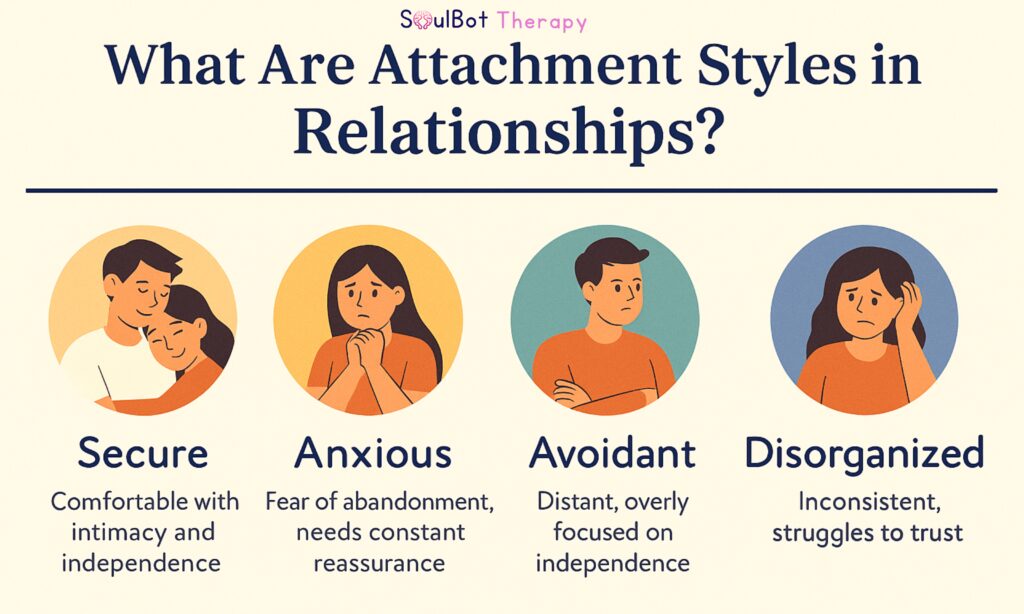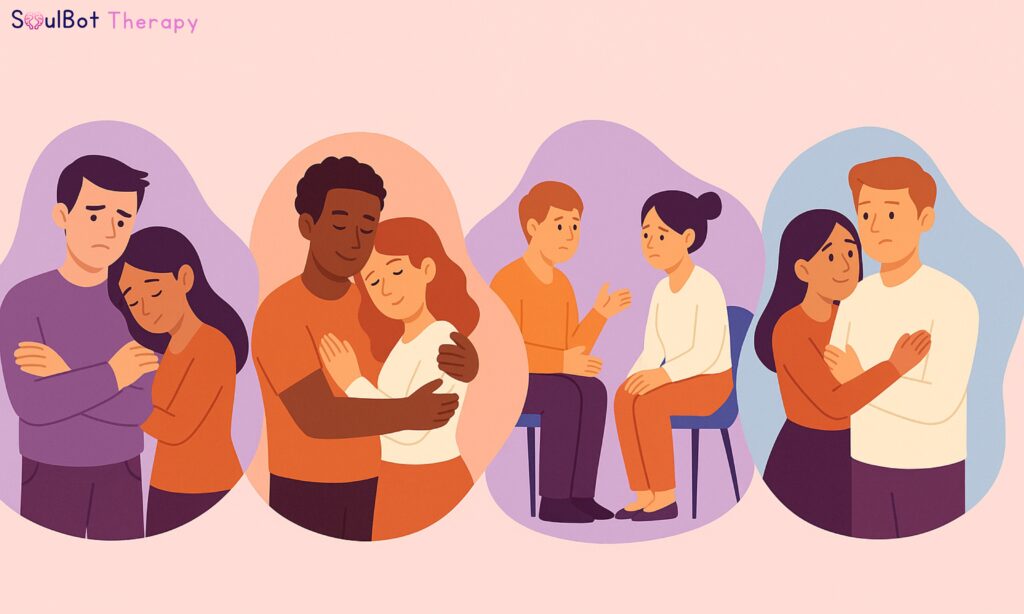Attachment styles in relationships silently shape how we love, connect, and cope.
Whether you cling to closeness, fear vulnerability, or crave stability, these behaviors aren’t random — your early emotional experiences wire them.
And if you’ve ever asked, “Why do I always attract emotionally unavailable people?” — you’re in the right place.
Let’s break down the 4 main types of attachment styles, how they affect adult relationships, and how tools like AI Mental Health Support can help you recognize and rewire these patterns.
What Are Attachment Styles in Relationships?
Attachment styles refer to emotional templates we develop in childhood and carry into adult relationships.
They impact:
- How we trust
- How do we express needs
- How we react to distance, conflict, or vulnerability
📊 Soul Fact: According to APA, attachment theory explains why some people thrive in connection while others struggle with dependence or withdrawal.

The 4 Types of Attachment Styles (With Signs)
✅ 1. Secure Attachment
- You trust easily, express emotions well, and resolve conflict constructively.
- Relationships feel safe, not consuming.
⚠️ 2. Anxious Attachment
- You seek closeness but fear abandonment.
- Common signs: overthinking texts, needing constant reassurance.
❄️ 3. Avoidant Attachment
- You value independence but fear intimacy.
- Common signs: shutting down during conflict, withdrawing after closeness.
🔄 4. Disorganized (Fearful) Attachment
- A mix of anxiety and avoidance.
- Common signs: push-pull behaviors, emotional overwhelm, trust issues.
These types of attachment styles develop as coping strategies, not character flaws.
How Attachment Styles Affect Love, Communication & Trust
Let’s look at how they show up in daily emotional life:
| Behavior | Attachment Trigger | Root Style |
| Constantly checking if someone is “mad” | Emotional distance | Anxious |
| Feeling suffocated after expressing affection | Vulnerability | Avoidant |
| Overthinking and pulling away after intimacy | Safety confusion | Disorganized |
| Stating needs and resolving conflict calmly | Safety & self-worth | Secure |
Attachment Issues in Adults: Signs to Watch For
Common signs of attachment issues in adults include:
- Avoiding deep conversations
- Feeling “too much” for needing affection
- Choosing emotionally unavailable partners
- Shutting down during emotional moments
- Always “chasing” or always “running.”
If you resonate with any of these, you’re not broken.
You’re carrying emotional maps that can be redrawn — with the right tools.
Can You Change Your Attachment Style? (Yes.)
✅ Absolutely — your attachment style is malleable, especially with:
- Emotional awareness
- Safe, consistent relationships
- Reflective tools like AI Counseling and Mental Health Companions
- Intentional reparenting practices
With consistent AI Therapy support, you can observe triggers, practice boundary-setting, and shift toward secure attachment through real-time reflection.
Using AI Mental Health Support to Heal Attachment Patterns
📲 Platforms like SoulBot Therapy offer:
- Daily check-ins on emotional responses
- Journaling tools to process conflict patterns
- Conversation scripts for expressing needs
- Nonjudgmental insight into repeated behavior cycles
It’s not a replacement for therapy, but it’s accessible, constant support when emotional clarity is hard to find.
You can heal quietly. Privately. Consistently.
You’re Not “Too Much” or “Too Distant.” You’re Patterned — and You Can Heal.
Your attachment style isn’t your fault.
But understanding it? That’s your power.
With support, reflection, and tools like SoulBot — your AI Mental Health Coach, you can build relationships that feel safe, stable, and satisfying.








